Introduction
Since the 18th National Congress of the Communist Party of China (CPC), the Central Committee of the CPC with President Xi Jinping as the core leader has actively implemented an innovation-driven development strategy, attached immense importance to intellectual property rights protection, and made major strategic decisions and arrangements for the establishment of the Intellectual Property Court of the Supreme People’s Court (hereinafter referred to as “the IP Court”) to build China into an IP power and a science and technology power in the world. On January 1st, 2019, the IP Court was officially unveiled and became the first specialized IP court at the highest court level worldwide. The IP Court exercises final instance judicial function by hearing appeals on patents, monopoly and other technology-related IP cases from across China. It also undertakes the responsibilities and mission to further unify judicial standards for technology-related IP cases, improve the quality and efficiency of trials, enhance judicial trustworthiness and international influence, and provide judicial guarantees for strengthening innovation-driven development strategies and the implementation of national intellectual property strategies.
Since its establishment, guided by the Xi Jinping Thought on Socialism with Chinese Characteristics for a New Era, the IP Court has comprehensively implemented the decisions formulated at the 19th National Congress of the CPC, and the second, third and fourth plenary sessions of the 19th Central Committee of the CPC, enhanced “Four Consciousnesses”, fostered “Four Matters of Confidence”, and ensured “Two upholds”. Focusing on the duties and missions entrusted by the Party Central Committee, the IP Court actively seeks a holistic approach at the highest judicial level to both the domestic and international situations, focusing on the “high starting point, high caliber, high level, and international standards” and adhering to the court motto of “Innovation, Perseverance, Prudence, and Preeminence,” and continues to deepen reforms in the field of technology-based intellectual property trials and gives full play to the function of technology-related intellectual property trials to stimulate and protect innovation and to promote scientific and technological progress and social development, so as to safeguard and serve the overall national economic and social development, to contribute Chinese experience and wisdom in the formulation of international intellectual property protection practice and rules, and to strive to promote open, inclusive, balanced, and effective development of international intellectual property rules and governance systems.
Ⅰ. Focus on the function of trial to strengthen typical exemplary effect of model cases and further unify the standards for adjudicating technology-related IP cases
Unifying the standards for adjudicating patent and other technology-related IP cases is the primary goal of the IP Court. In 2019, the IP Court focused on the function of trial and concluded a number of closely technology-related IP cases justly and efficiently in accordance with the law. A number of model judgments that have typical exemplary effect were made, and the “systematization project to unify judicial standards” has been implemented, further promoting the unification of judicial standards for technology-related IP cases.
1. Focus on the function of trial to try cases fairly
In 2019, the IP Court accepted a total of 1,945 technology-related IP cases and concluded 1,433 cases, with a closing rate of 73.7%. Among the newly accepted cases, 962 were civil substantive cases of second instance, of which 586 were concluded; 241 were administrative cases of second instance, of which 142 were concluded; 481 were challenge to jurisdiction cases of second instance, of which 446 were concluded; and 261 were other types of cases, of which 259 were concluded.
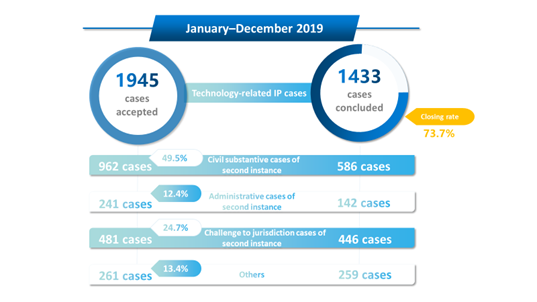
(1) Statistical analysis of the cases
① Statistical analysis of the source of cases
In 2019,the IP Court accepted a total of 1,684 various types cases of second instance. Among them, 1,678 were appealed against judgments made by Intermediate People’s Courts in the first instance, accounting for 99.6%; and 6 were appealed against judgments made by High People’s Courts in the first instance, accounting for 0.4%.
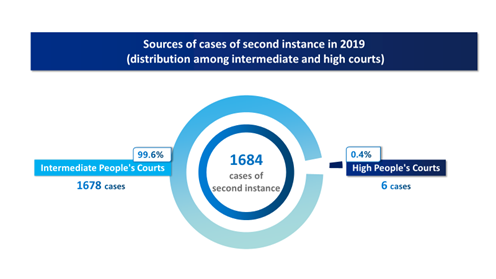
In terms of the source regions of the cases, the top ten include: Beijing Intellectual Property Court (376 cases), Guangzhou Intellectual Property Court (297 cases), Shanghai Intellectual Property Court (143 cases), Nanjing Intellectual Property Tribunal (107 cases), Shenzhen Intellectual Property Tribunal (96 cases), Ningbo Intellectual Property Tribunal (85 cases), Suzhou Intellectual Property Tribunal (71 cases), Hangzhou Intellectual Property Tribunal (70 cases), Qingdao Intellectual Property Tribunal (67 cases), and Jinan Intellectual Property Tribunal (53 cases). The above data roughly reflect the distribution of technology-related IP disputes across the country. It is clear from the above data that economically developed regions tend to have more economic activities involving technology-related intellectual property and accordingly, there are more related disputes.
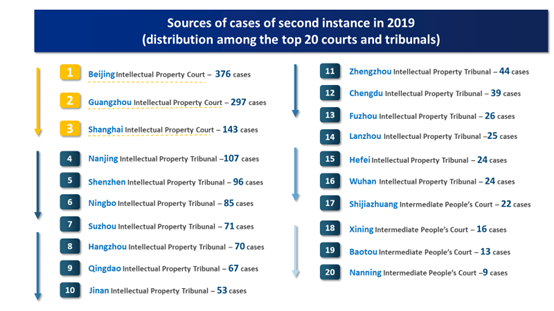
② Statistical analysis of the types of cases accepted
Among the 962 civil substantive cases of second instance accepted by the IP Court, there were 454 disputes over infringement of utility model patent rights, 234 disputes over infringement of invention patent rights, 142 disputes over computer software, 40 disputes over patent agency and licensing contracts, 26 disputes over technical contracts, 20 disputes over new plant variety rights, 12 disputes over technical secrets, 9 disputes over monopoly, 9 disputes over patent application rights and patent ownership, 8 disputes over confirmation of non-infringement, 7 disputes over remuneration to service inventors, and 1 dispute over layout design of integrated circuits. The majority of the cases are disputes over infringement of utility model patent rights (47.2%), disputes over infringement of invention patent rights (24.3%), and disputes over computer software (14.8%).
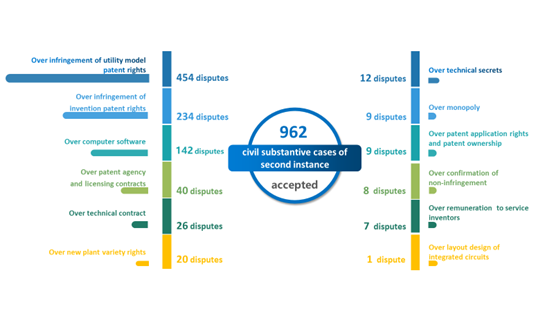
Among the 241 administrative cases of second instances accepted by the IP Court, there are 230 cases of administrative grant and affirmation, 7 administrative penalty cases, and 4 other administrative cases. Among the cases of administrative grant and affirmation, there are 80 administrative disputes over invalidation of patent rights, 71 administrative disputes over reexamination of invention patent applications, 57 administrative disputes over invalidation of utility model patent rights, 9 administrative disputes over reexamination of utility model patent applications, and 13 administrative disputes over invalidation of design patent rights. The majority of the cases are administrative disputes over invalidation of invention patent rights (33.2%), administrative disputes over reexamination of invention patent applications (29.5%), and administrative disputes over invalidation of utility model patent rights (23.7%).
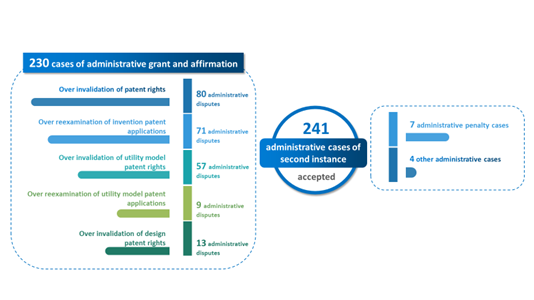
③ Statistical analysis of judgment results
In 2019, the IP Court concluded a total of 1,174 cases of second instance. Among them, 731 cases were concluded with the decisions of the first instance being affirmed; 280 cases were concluded with the appeals being withdrawn, 71 cases were concluded through mediation, with the mediation and withdrawal rate of 29.9%; and 92 cases were concluded by either being sent back for retrial or reversal of decisions on appeal, with the send back and reversal rate of 7.8%. Of the 92 send back for retrial or reversal cases concluded by the IP Court, there were 66 civil substantive cases of second instance, 21 cases of second instance on challenge to jurisdiction, and 5 administrative cases of second instance.

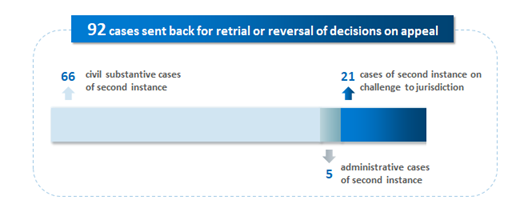
Of the 586 civil substantive cases of second instance concluded by the IP Court, 236 were concluded with the decision of the first instance being affirmed; 213 cases were concluded with the appeals being withdrawn, 71 cases were concluded through mediation, with the mediation and withdrawal rate of 48.5%; and 66 cases were concluded by either being sent back for retrial or reversal of decisions on appeal, with the send back and reversal rate of 11.3%.
Of the 142 administrative cases of second instance concluded by the IP Court, 126 cases were concluded with the decision of the first instance being upheld; 11 cases were concluded with the appeals being withdrawn; and 5 cases were concluded by reversal of decisions on appeal, with the reversal rate of 3.5%.
Of the 446 cases of second instance on challenge to jurisdiction concluded by the IP Court, 369 cases were concluded with the decisions of the first instance being affirmed; 56 cases were concluded with the appeals being withdrawn; and 21 cases were concluded by reversal of decisions on appeal, with the reversal rate of 4.7%.
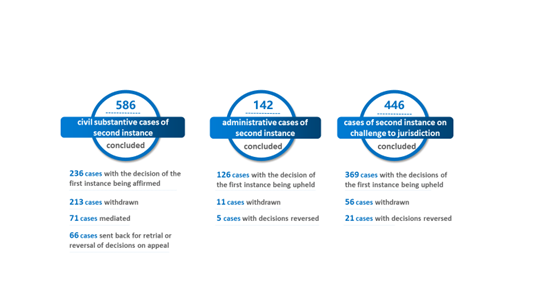
④ Statistical analysis of trial period
![]()
In 2019, the average trial period for substantive cases of second instance tried by the IP Court was 73 days, and 29.4 days for cases of second instance on challenge to jurisdiction. The closing rate was 39.2 cases per judge.
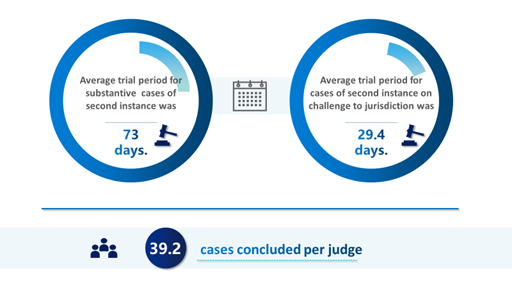
⑤ Statistical analysis of cases involving a party from foreign country, Hong Kong, Macau, and Taiwan Region
In 2019, the IP Court accepted 174 cases involving a party from foreign country, Hong Kong, Macau, and Taiwan region. Among them, there were 50 civil substantive cases of second instance, 52 administrative cases of second instance, 71 cases of second instance on challenge to jurisdiction, and 1 other case. By region, there were 75 cases involving EU countries, 54 cases involving the United States, 15 cases involving Japan, 4 cases involving South Korea, 2 cases involving Canada and Israel, respectively, 1 case involving Australia and South Africa, respectively, and 20 cases involving Hong Kong, Macau and Taiwan.
The IP Court concluded 98 cases involving a party from foreign country, Hong Kong, Macau, and Taiwan region. Among them, 35 substantive cases were concluded, of which 21 were won by foreign parties (including partially won), 3 were won by Hong Kong, Macao and Taiwan parties, and 11 were won by parties of the Chinese mainland.
![]()
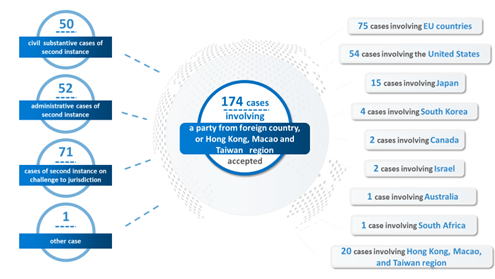
(2) Case characteristics analysis
① Overall characteristics of cases
In 2019, technology-related IP cases tried by the IP Court share the following characteristics: they involve a wide range of technologies; they have a large social impact; many of them involve interconnected procedures; the trial period is short; the legitimate rights and interests of Chinese and foreign parties are equally protected; and the direction for increasing the judicial protection is clear.
(i) The cases involve a wide range of technologies. The types of intellectual property rights claimed by the parties involve many fields that are closely related to national economy, people’s livelihood, cutting-edge technology, clothing, food, housing, and transportation, including medicine, gene, telecommunications, machinery, agriculture, and forestry.
(ii) The cases have a large social impact. One is the high market value of the intellectual property involved in the cases. There are 17 cases of first instance in which the obligee claimed infringement damages of over RMB 10 million, including 3 cases with claims over RMB 100 million. Two is the high degree of attention from society when the cases involve cutting-edge technologies or national economy and people’s livelihood, such as standard essential patents (SEPs), pharmaceutical patents, etc.
(iii) The cases involve interconnected procedures. The IP Court accepted many mutually competitive litigation cases where the parties file multiple civil and administrative litigations against each other in different courts. There were many related cases involving different trial levels and different procedures. The IP Court achieved good results by coordinating and handling the cases from the aspects of trial procedures, judgment standards, holistically mediation, etc., and the percentage of mediation and withdrawal rate of second instance cases concluded in 2019 was 29.9%.
(iv) The trial period of the cases is short. Due to various factors such as interconnected civil and administrative procedures, and difficulty in finding technical facts, the trial period for technology-related IP cases is generally longer. However, the average trial period for substantive cases of second instance concluded by the IP Court in 2019 was only 73 days, which indicated that the trial period for cases involving the protection of technology-related intellectual property rights had been considerably shortened.
(v) The legitimate rights and interests of Chinese and foreign parties are equally protected. The cases involving a party from foreign country, Hong Kong, Macau, and Taiwan region accounted for 8.9% of all cases accepted by the IP Court. Some of the cases were part of transnational litigation between the parties, which interplayed with foreign patent infringement litigation and together constituted an integral part of the parties’ business competition strategy. The IP Court continues to insist on equal treatment and equal protection of the intellectual property rights of both Chinese and foreign market entities of various types, according to law.
(vi) The direction for increasing the judicial protection is clear. A good-faith litigation mechanism is adopted and in the event of refusal to perform an order on presenting documents, intentional damage to the product in preservation, etc., a presumption of fact against the actor is taken. Among the cases concluded, cases supporting the obligee’s claims according to law, account for 61.2%.
② Characteristics of civil patent cases
The civil patent cases heard by the IP Court have the following characteristics:
(i) There are many cases where claim construction and the determination of equivalent infringement are the main disputes. Since claim construction is related to the determination of the scope of protection of patent rights and the result of comparing infringing technologies, through the judgment in individual case, the IP Court conducts in-depth exploration of the identification criteria of functional features, the limitation of subject names on the protection scope of the claims, and the application of the dedication doctrine. As there are many cases involving the judgment of equivalent infringement, how to maintain the publicity function of patent claims while granting fair protection to patent holders becomes the main difficulty in hearing such cases.
(ii) The legitimate source defense, the prior art defense, and the preemption defense are the most common defenses. Cases where the legitimate source defenses are proposed, account for the largest proportion, and most of the disputes focus on the distribution of burden of proof and the scope of exemption from liability for damages. The prior art defense is relatively arbitrary, and parties who file or present the prior art defense for the first time during the second-instance procedure, account for a large proportion.
(iii) Related cases with commercial rights protection account for a certain proportion. In such cases, the obligee carries out large-scale and centralized commercial rights protection across the country with the same patent. Most of the patents involved are utility model patents that have not been substantively examined, and most of the alleged infringers are small downstream vendors in the goods supply chain.
③ Characteristics of administrative cases concerning patents
The administrative cases concerning patents heard by the IP Court have the following characteristics:
(i) There are many cases involving invention patents and high-tech fields. Among the three types of patents, invention patents are the most technical, and invention patent cases rank first among declaration of invalidity cases and reexamination cases, reflecting the importance attached to patent value by inventors and the relevant public. In terms of the technical field, most number of cases involves the mechanical field, but among declaration of invalidity cases, cases in the electrical field and the mechanical field account for the most number. There are also many disputes in high-tech fields such as telecommunication technology and computers. Although the total number of declaration of invalidity cases is small in the chemical field, they are generally concentrated in important industries such as pharmaceuticals and biotechnology.
(ii) Judgment of inventiveness is the main dispute in most cases. There were a total of 92 cases involving inventiveness judgment, accounting for about 70% of patent administrative cases, and among the cases where the judgment of the first instance was reversed, 80% involve examination of inventiveness. In the trial of such cases, the IP Court judges attach importance to determination of non-obviousness by using the “three-step approach”, standardize auxiliary considering factors such as commercial success, and explore judgment of inventiveness concerning compound medicines in new crystalline form, preserved biomaterials, etc., so as to ensure that truly valuable inventions are protected according to law.
(iii) Among the cases sent back for retrial, many cases have natural persons as the applicants. Of the 57 reexamination cases, 75% of the cases have natural persons as the applicants. Most of them were dismissed due to lacking of inventiveness, and a few lacking of either practical applicability or patent subject matter eligibility. The applicants were natural persons in 10 cases where the cases were not accepted due to a misunderstanding of the calculation method for the time limit of litigation filing in patent administrative litigation.
④Characteristics of cases concerning computer software
Cases concerning computer software heard by the IP Court have the following characteristics:
(i) The types of the cases are relatively concentrated. There are mainly two types of software cases: contract cases and infringement cases and the former accounts for over 80% of its total number.
(ii) The focus of the disputes is relatively concentrated. In particular, software contract cases mainly focus on whether the software are developed and delivered, whether the software developed meets the agreement, whether the parties have agreed on the changes in performing the contract, and whether there is delay in performance, etc.
(iii) The difficulty of settlement varied greatly. In software infringement cases, if there is an argument about the technical facts of infringement, complex comparison of the source program, which proves difficult, is usually necessary between the allegedly infringing software and the copyrighted software; if no such argument occurs, the case is easy to solve. In software contract cases, if the agreement terms are vague or the performance standards are not well defined in the contract, the case is difficult to solve; otherwise, it proves easy.
⑤Characteristics of cases concerning jurisdiction
Cases concerning jurisdiction heard by the IP Court have the following characteristics:
(i) The number is large. Based on the litigation strategy, the complexity of jurisdictional rules, and the existence of more jurisdictional connection points, the alleged infringer has more arguments to challenge the jurisdiction in IP cases.
(ii) There are many new issues with great difficulties. These issues include whether the arbitration clause in the agreement applies to the jurisdiction of monopoly agreement disputes; whether the place where a monopoly agreement is reached can be considered as the connection point for the jurisdiction of monopoly disputes; can the network platform provider be taken as the connection point for jurisdiction in cases where the vendor is not sued; whether the place where the act of infringement is committed claimed by the patent owner can be the connection point for jurisdiction in the disputes over confirmation of non-infringement, etc. These issues reflect that with the continuous development of technology, business models, and rights protection practices, the jurisdiction of technology-related IP cases has become increasingly complex and diverse.
(iii) The judicial position is relatively lenient. Of the 446 cases of second instance on challenge to jurisdiction concluded by the IP Court, only 21 were concluded by reversal, accounting for 4.7%. In order to protect the obligee’s in exercising its litigation rights according to law and to moderately promote judicial competition, the IP Court has a more lenient judicial position towards the obligee’s choice of connection point of jurisdiction and respects the olibgee’s right to choose the court of dispute jurisdiction.
⑥ Characteristics of other types of cases
Cases concerning new plant variety rights heard by the IP Court have the following characteristics:
(i) The varieties involved are closely related to people’s daily lives, such as corn, rice, honey pomelo, flowers, etc.
(ii) The identification of technical facts is more difficult, and it is especially difficult to determine the “identity.”
(iii) The legal issues involved in the cases are diverse, such as the standing of parties in the litigation, the scope of protection of variety rights, the defense of legitimate sources, and the amount of damages, etc.
Most of the technical contract cases heard by the IP Court take the review and judgment of breach of contract as the focus of the trial, and the technical fact finding has a major impact on the determination of breach of contract.
The cases concerning technical secret heard by the IP Court involve many procedural issues, through which the IP Court has further clarified the procedural rules.
2. Create model cases with typical exemplary effect
Judgments rendered by the IP Court are judgments of the Supreme People’s Court, and are final and authoritative. The IP Court comprehensively leverages its centralized jurisdiction over technology-related IP cases of second instance to create model cases with typical exemplary effect, social influence, and uniform legal application standards.
On March 27th, 2019, the collegial panel of the IP Court consisting of Chief Judge Luo Dongchuan and Deputy Chief Judge Wang Chuang “struck the gavel for the first time” when they tried in public the first technology-related IP case—an invention patent infringement dispute of Xiamen Lukasi Automobile Parts Co., Ltd. and Xiamen Fuke Automobile Parts Co., Ltd. (Appellants) v. VALEO SYSTEMES D’ESSUYAGE (Respondent). From filing time of this second instance case to court hearing, closing and service of judgment, the IP Court took only 50 days. The case involved a frontier issue of preliminary judgment on patent infringement. Through this case, the IP Court clarified the criteria for determining functional feature, the unique value of the preliminary injunction when the preliminary decision involving the permanent injunction has not yet taken effect, and the applicable conditions and rules when the preliminary injunction and the preliminary judgment involving permanent injunction coexist. The case was identified as a guiding case by the Supreme People’s Court, and included in the “Top Ten Model Civil and Administrative Cases in 2019”.
Taking “this first gaveled case” as a model, the IP Court summarized its experiences from individual cases to try similar cases based on the characteristics of intellectual property in different technical fields, and established a number of model cases. For example, in the field of machinery, the invention patent infringement case of Wuxi Hisky Medical Technologies Co., Ltd. (Appellant) v. Echosens (Respondent) and China-Japan Friendship Hospital (Defendant in the first instance) was tried by the IP Court. The patent involved was that of a “non-invasive diagnostic instrument for liver disease.” The case established the rules for claim construction in patent infringement litigation, the distribution of burden of proof and the determination of the literal and equivalent infringement. In the field of pharmaceuticals, an administrative reexamination dispute over invention patent of the National Intellectual Property Administration, PRC (Appellant) v. Erasmus University Medical Center Rotterdam and Roger Kingdon Craig (Respondents) was tried by the IP Court. The IP Court clarified the relationship between the patent inventiveness examination and the full disclosure of the specification and other legal standards, promoted the inventiveness examination standards to return to the core and essence in patent examination, and gave clear guidance on how to avoid "hindsight" in the inventiveness examination. In the field of telecommunications, the invention patent infringement case of Shenzhen Jixiang Tenda Technology Co., Ltd. (Appellant) v. Shenzhen Dunjun Technology Co., Ltd. (Respondent) involved the patent for “a method for easy access to a portal website of a network operator”. This case, taking the technical characteristics of the network telecommunication field as an important consideration, set up a new adjudication rule on multi-actor method patent infringement, that is, if the alleged infringer, without the patentee’s permission, realizes the substance of the patented method of the allegedly infringing product for the purpose of production and operation, and plays an irreplaceable and substantial role in the comprehensive coverage of the technical features of the patent claims; then in such a case, it should be held as an infringement on the method patent. In the field of new plant varieties, the case of dispute over new plant variety rights of Cai Zinguang (Appellant) v. Guangzhou Runping Commercial Co., Ltd. (Respondent) involved a “three red pomelo” new plant variety. The case established the adjudication rules on the scope of protection of new plant variety rights and the determination of an infringement. It established that where the plant is both propagating and harvested material, the true intention of the allegedly infringing seller to sell it as a propagating material or harvested material should be examined.
3. Implement a systemization project to unify judicial standards
Over the past year, the IP Court has built and implemented the “systemization project to unify judicial standards”, and established a working system with special standards, subsection guarantees, and strict management of key points, providing institutional and system guarantees for the unified judicial standards for technology-related IP cases.
With respect to system development, the “Implementation Rules for Unifying Judicial standards of the IP Court” was formulated, which clarifies and distributes cases involving the same patent to the same judge or collegial panel in principle, to ensure the uniformity of judicial standards. With respect to front-end sorting, multiple measures such as system comparison and manual review have been adopted to identify similar cases. Civil cases involving the same patent, interconnected civil-administrative cases, and cases with related parties, are collectively allocated to the same collegial panel. With respect to mid-end control, the judge meeting system has been improved. The IP Court held 34 judge meetings throughout the year, unified 120 adjudication rules, and issued the Excerpts from the Minutes of Judge Meetings and Tips for Handling Cases, so that judges can master important judicial standards and case handling methods in a timely manner. Using platforms such as “The IP Court Forum” and “The New Knowledge Lecture Hall,” the IP Court managed to establish adjudication consensus within the IP Court. It also organized “The IP Court Work Deployment and Professional Training Courses” and “Adjudication Practice Training Courses for Technical Cases in People’s Courts,” to strengthen transmission of guidance and adjudication rules to the lower courts. With respect to back-end review, the judge meetings have been used to check the judgment documents of model cases and major sensitive cases. A document evaluation system has been set up to improve the quality of judgment documents. With respect to key cases, a special case report and guidance mechanism for major cases has been established, with 28 Work Information of the IP Court issues and special issues being compiled and distributed, to provide references for leadership decisions.









